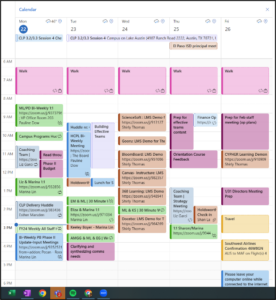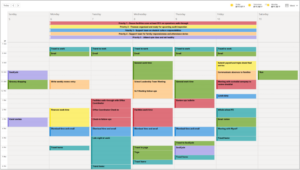At a recent Together Leader workshop in Washington, DC, a participant posed the following question:
How do I manage a busy calendar in conjunction with my partner?
This Together Leader has a busy leadership role in an education non-profit, and her partner works a heavy-travel international job. They’re also raising an 18-month-old child to boot!
Her question was a very good one. Literally 100% of her fellow session participants nodded in empathy. Another workshop participant shared, “We have a weekly family meeting to figure out which of our children is where (three children, all with different childcare situations), what we are eating, and how to inject some fun into the week.” When I asked, “Why bother?” the participant answered comically, “It keeps us married!” The group erupted in applause. So, we took a 20-minute workshop detour, and I’m back now to share the results. It is ALL ABOUT THE FAMILY MEETING. The wonderful book The Secrets of Happy Families alludes to this a little bit, but I rarely see any resources on the nitty-gritty mechanics of how to get it done.
Here are two models I like.
Bill and Katie, an education powerhouse couple in New Orleans, have a sacred family meeting at Panera Bread each Sunday. Their kindergarten age son hangs with his grandparents at this time. They were kind enough to share a generic version of their weekly agenda:

I love how their meeting goes beyond their tasks and calendar. They really take time to focus on long-term items like schooling for their son, holding career discussions, and maintaining spiritual health. Both of them literally swear this meeting is THE KEY to their relationship. And then, they took it a step further, and added Family Meeting Ground Rules! I love this.
The 8 Family Meeting Rules (as told by Bill)
- Agenda in Advance – It’s important that both partners know every item that is on the agenda before the meeting. No new items can be added without the other’s awareness or opportunity to review. It would be horrible if one partner discovered the other was, possibly passive aggressively, filling the agenda with a number of “ambush items.”
- Sacred Time/Space – This set aside of 90 to 120 minutes is to be treated as more important than almost any other time/space. We tell people that we are unavailable because we have family meeting. It is part of the routine of our friendships so folks know we are simply not available from 10:00 am to noon on Sunday (recently moved to Saturday). Family meeting topics should also not seep into other aspects of our life. If we are having a Friday date night, we should be talking about a book one of us is reading, a TV show or movie one of us enjoyed, something important from our day, a news item of mutual interest, or how beautiful/handsome we find each other. It should not be about running errands, selling our car, or if we should find a new church to attend.
- Public Meeting – Holding the meeting in a public location ensures we cannot get distracted by immediate tasks or housework. It also makes it harder to call a premature end to the meeting if the discussion gets challenging. Perhaps most importantly, holding the meeting in public encourages that we stay focused on the work of the meeting, adopting a publicly acceptable demeanor and minimizing strong expression of emotions that may need expressing but could get in the way of making decisions and getting things done.
- Reserve Conflicts – During the week, the time we spend together is precious and it is really challenging if it gets consumed by minor conflicts. Therefore, if a conflict arises the aggrieving partner can always say to the other partner, “I hear you’re upset. Is there anything I can do to fix it enough right now so that it can wait until family meeting?” Sometimes the answer is, “Nothing. I want to hash this out right now.” More often than not though, the fix is quick and easy, and by the time we talk about it at family meeting we realize either it was not a big deal or it indicated some underlying conflict that would be better surfaced during the calm of family meeting.
- Work the Agenda – It’s really easy to just cover the easy things and then find reasons to push the hard items off or get distracted. If anything, we sometimes reverse the agenda and start with the hard items in an effort to ensure they get addressed. We also find it helpful to assign items to a specific partner (on the agenda it’s with a letter of that person’s first name before items uniquely held or managed by him/her). Finally, we move items around the agenda based on their gravity. For example, we might move our son’s week under hard items because we are conflicted about how to deal with a particularly challenging behavior.
- Turn Tech Off – Use minimal technology with the least connectivity possible. It’s important that we are mentally present for the full time. Have only the technology available that you need for that part of the meeting/that task.
- Allow an Out – Despite the public setting and structure, “hard items” are hard for a reason. We sit close enough to the bathroom that if one of us needs to go cry in the men’s or women’s room, s/he can do that. Sometimes even that is not enough, and there is nothing productive about forcing one’s partner to publicly discuss something that is too hard in that moment. When those items arise, we sometimes move them to the next week or set aside a special time to discuss that particular item in a more private, more emotionally safe setting.
- Sit Nearly Adjacent – Sitting nearly adjacent to each other (unless you’re in a booth in which case… what can you do?) is really helpful because it means you can see the same screen or paper. It also prevents the adversarial positioning of an “across the table” conversation.
And while Bill and Katie’s agenda was just for the two of them, as your children become older, they can join in. Here is one sample from a former K-8 principal in Brooklyn – and mom of three teenage girls! My favorite section is “Which book you are reading?”

So, there you have it. Many couples really do just “fall in” to default patterns on this stuff, chronic ambushes on logistics, and many crossed wires on who is going where when (#beenthere). In EVERY single workshop I run, it is named as a source of tension. If you hate these ideas, then clearly don’t do them, but I consistently hear reports of greater happiness and more fun when these practices are implemented.
Do you have a weekly family meeting? What’s on your agenda?


